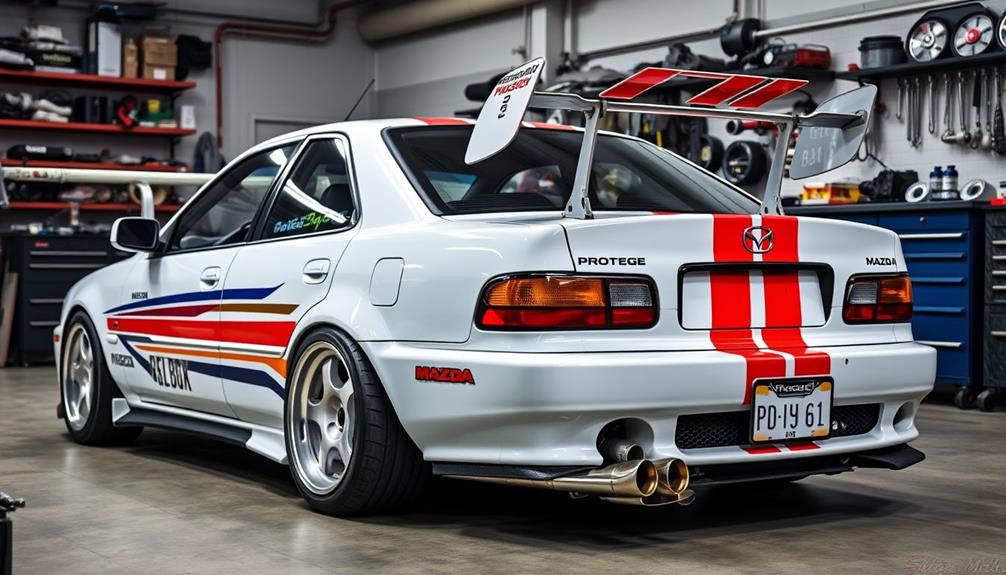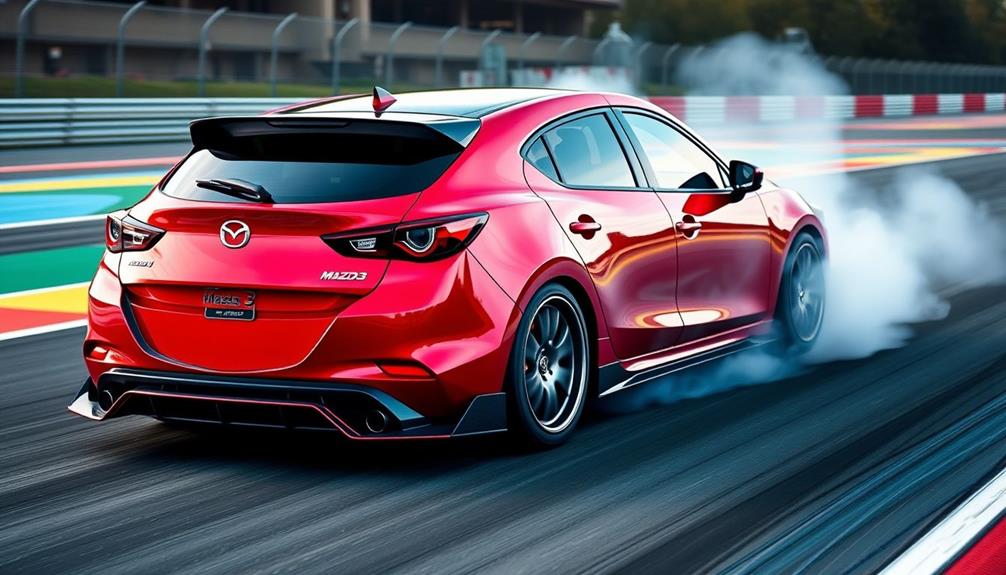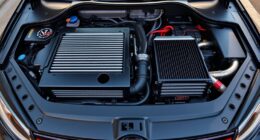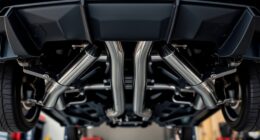If you're tuning your 1995 Mazda Protege, you're looking to boost its performance and efficiency. Start with bolt-on upgrades like a short ram intake, performance headers, and a cat-back exhaust system to improve airflow. For more power, consider forced induction with a turbocharger, or focus on lightweight components for a naturally aspirated setup. Don't forget to upgrade the ignition system and invest in a performance-tuned ECU for optimized fuel and ignition mapping. These modifications can elevate your Protege to 180-200 hp, enhancing your driving experience. There's plenty more to explore that can take your build to the next level.
Key Takeaways
- Upgrade the intake system with a short ram intake for improved airflow and performance efficiency.
- Install performance headers and a cat-back exhaust system to enhance exhaust flow and reduce back pressure.
- Consider a lightweight flywheel and a performance clutch kit for better throttle response and power handling.
- Upgrade the ignition system with high-performance coil packs and quality spark plugs for improved combustion and engine responsiveness.
- Tune the ECU properly to optimize fuel injection and ignition timing, ensuring compatibility with all modifications.
Modification Overview and Goals
When tuning your 1995 Mazda Protege, your primary goal is to boost its performance to around 180-200 hp at the crank, which translates to about 120 hp at the wheels.
To achieve this, you'll want to focus on a solid modification overview that sets the foundation for your performance upgrades.
Start with common upgrades like enhancing the intake, header, and exhaust systems. These modifications optimize airflow and improve engine efficiency without compromising daily drivability.
Upgrading these components will offer noticeable gains in performance while keeping your Protege practical for everyday use.
Next, consider enhancing your ignition system and using high-quality plug wires. These essential bolt-on modifications can lead to significant improvements in engine responsiveness.
As you progress, you might look into more advanced upgrades like internal modifications, including pistons and camshafts, along with top-end enhancements like porting and polishing.
Each of these steps will help maximize your engine's breathing and overall power output.
Forced Induction Vs. Naturally Aspirated
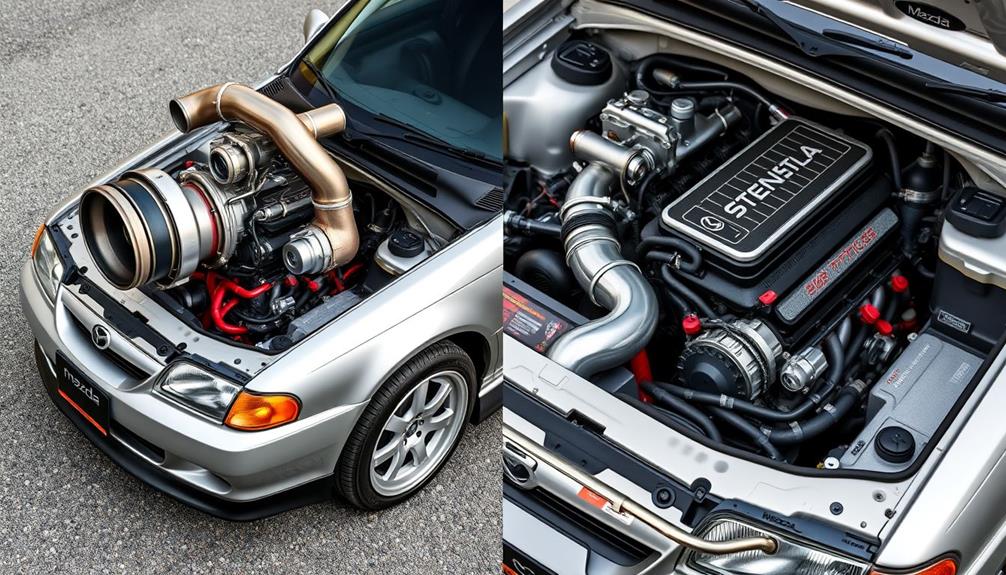
Choosing between forced induction and naturally aspirated setups can make or break your tuning plans for the 1995 Mazda Protege. If you're after a considerable power increase per dollar, forced induction, like turbocharging, often delivers. Turbocharged engines create boost based on engine load, enhancing power efficiency, which can be a game changer for your compact car.
However, larger turbos, such as the GT30 or GT35, can greatly boost horsepower but may introduce lag, impacting street drivability. This is vital if you plan to use your Protege as a daily driver.
On the other hand, naturally aspirated setups typically focus on optimizing airflow through lighter components and improved intake and exhaust systems. While naturally aspirated mods mightn't provide the same power gains as forced induction, they excel in improving acceleration by reducing rotational mass.
Ultimately, understanding the trade-offs between these two approaches is essential. Forced induction caters to those looking for a big boost in power, while naturally aspirated setups appeal to drivers seeking a more connected and linear driving experience. Your choice will influence your overall vehicle usability and performance goals.
Essential Bolt-On Modifications
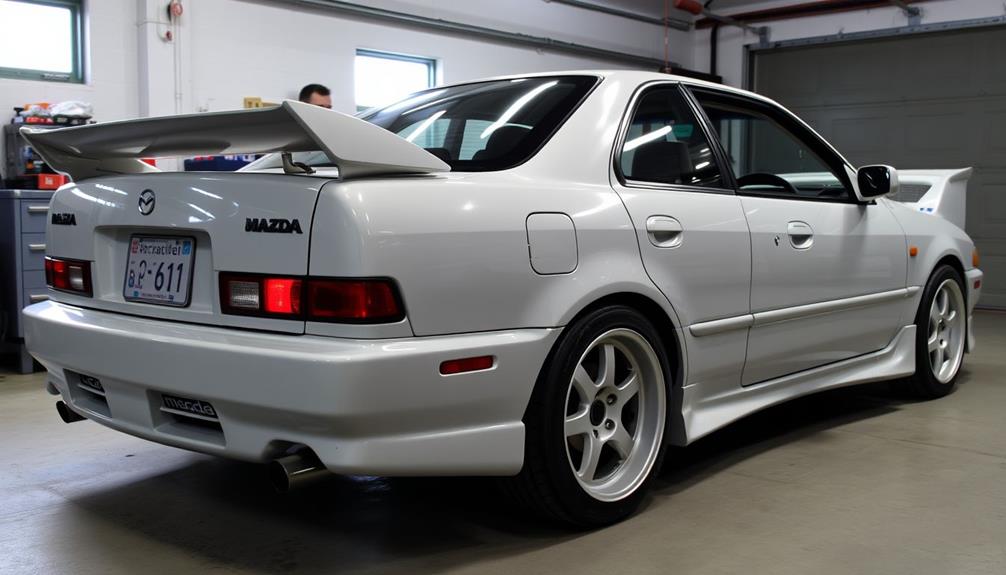
Bolt-on modifications are a fantastic way to enhance the performance of your 1995 Mazda Protege without the complexity of extensive engine work.
Start by upgrading your intake system; short ram intakes are often more efficient than cold air intakes, reducing heat soak and optimizing airflow. This improvement can greatly impact your car's performance.
Next, consider installing performance headers with equal-length runners to enhance exhaust flow. This modification contributes to higher horsepower and a more responsive power band.
Pair this with a cat-back exhaust system to reduce back pressure while keeping sound levels in check, allowing your engine to breathe easier and improving overall efficiency.
Don't forget about the ignition system. Upgrading to high-performance coil packs and quality spark plugs, like platinum or E2 plugs, can greatly enhance combustion and throttle response.
By combining these essential bolt-on modifications, you're looking at achieving performance goals of approximately 180-200 hp at the crank, translating to around 120 hp at the wheels, all while maintaining daily drivability.
With these upgrades, your Protege won't only perform better but will also provide a more enjoyable driving experience.
Advanced Engine Upgrades

When you're ready to take your Mazda Protege's engine to the next level, consider internal component enhancements and porting and polishing techniques.
Upgrading parts like the camshaft and investing in quality pistons can boost performance while improving durability.
Plus, refining the airflow through porting will elevate your engine's efficiency, giving you the power you crave.
Internal Component Enhancements
Upgrading the internal components of your Mazda Protege 1995 can dramatically elevate your engine's performance. By focusing on internal component enhancements like replacing stock pistons and rods, you can greatly boost your engine's compression ratio and durability. This leads to improved power output and better performance, especially under stress.
Consider camshaft upgrades as well. Options like 260, 262, or 268 profiles enhance valve timing and lift, allowing for better engine breathing and increased horsepower, particularly at higher RPMs.
Additionally, enhancing your valvetrain with upgraded springs and retainers guarantees valve responsiveness and prevents valve float, essential for high horsepower applications.
Don't overlook the importance of professional machine work on your engine head. Milling for increased compression and precise porting is critical for achieving peak flow characteristics.
These internal component enhancements work in synergy to create a robust engine that can handle performance modifications while maximizing power output. By investing in these upgrades, you're setting the foundation for a thrilling driving experience with your Mazda Protege 1995.
Porting and Polishing Techniques
To open the full potential of your Mazda Protege 1995, mastering porting and polishing techniques is essential. This process involves reshaping and smoothing the intake ports and exhaust ports to enhance airflow, ultimately improving engine performance and efficiency.
Start by using progressively finer grit sandpaper—80, 120, and 180—to carefully remove material and create a polished surface. This reduces turbulence and increases gas velocity, allowing your engine to breathe better.
Be cautious while modifying port shape and size; over-porting can negatively impact drivability by lowering gas velocity at lower RPMs. Significant reshaping of exhaust ports is often necessary to remove sharp corners that create bottlenecks. This facilitates smoother exhaust flow and reduces back pressure, enhancing overall performance.
Documenting your porting and polishing process with photos and videos not only provides you with valuable insights but also allows for performance comparisons before and after modifications.
Drivetrain Enhancements for Performance

When tuning your Mazda Protege, enhancing the drivetrain is key to unblocking better performance.
You'll want to contemplate lightweight flywheels for improved throttle response and upgrading the clutch for better power handling.
It's also essential to guarantee all components are compatible to maximize efficiency and avoid issues down the road.
Lightweight Flywheel Benefits
A lightweight flywheel can transform your Mazda Protege's performance by markedly reducing rotational mass. This reduction allows your engine to rev more quickly, greatly improving throttle response—especially useful for performance driving. By saving anywhere from 5 to 15 pounds compared to the stock flywheel, you'll notice gains in acceleration and overall engine performance.
When you install a lightweight flywheel, you enhance your engine's power-to-weight ratio. This upgrade makes gear changes feel more responsive, giving you a more engaging driving experience.
Keep in mind, though, that while you'll reap the benefits at high rpms, you might experience a slight trade-off in low-end torque. For spirited driving or track use, though, these high-rpm advantages often outweigh any drawbacks.
It's essential to verify compatibility between your lightweight flywheel and clutch system to prevent issues like chatter or premature wear, which can disrupt drivability.
If you prioritize performance and responsiveness, a lightweight flywheel is a worthy addition to your Mazda Protege, allowing you to enjoy a more exhilarating ride.
Clutch Upgrade Options
Upgrading the clutch in your Mazda Protege is vital for maximizing performance and handling increased power effectively. One of the best options is to invest in performance clutch kits, which typically feature higher clamping force and durable materials.
These kits can handle increased power and torque without slipping, ensuring a more reliable connection between your engine and drivetrain.
Pairing your clutch upgrade with a lightweight flywheel can greatly enhance your vehicle's responsiveness. A lighter flywheel reduces rotational mass, improving acceleration and engine responsiveness.
However, it's important to match the weights of your clutch and flywheel to avoid compatibility issues that could lead to performance problems or failure.
When choosing a clutch, consider options like organic, ceramic, or sintered types. Each offers different levels of grip and drivability tailored to your performance goals.
Additionally, upgrading the clutch master and slave cylinders will enhance pedal feel and provide quicker engagement, making spirited driving or racing even more enjoyable.
Drivetrain Component Compatibility
Ensuring drivetrain component compatibility is fundamental for maximizing your Mazda Protege's performance. One key strategy is drivetrain lightening, which reduces rotational mass and allows for quicker acceleration and better engine response. Upgrading to a lighter flywheel, for instance, can considerably enhance throttle response. You can find options weighing as little as 10-12 lbs, compared to the stock weight of around 18-20 lbs.
However, you must guarantee compatibility between the clutch and flywheel; mismatched weights can lead to potential failures, so careful selection is essential. A performance-oriented clutch upgrade, like a stage 1 or stage 2 option, provides better grip and minimizes slip, which is critical for handling the increased power from your modifications.
Additionally, integrating a short-throw shifter can further improve your driving experience. It enhances shifting precision and reduces shift times, contributing to quicker acceleration.
ECU Compatibility and Tuning
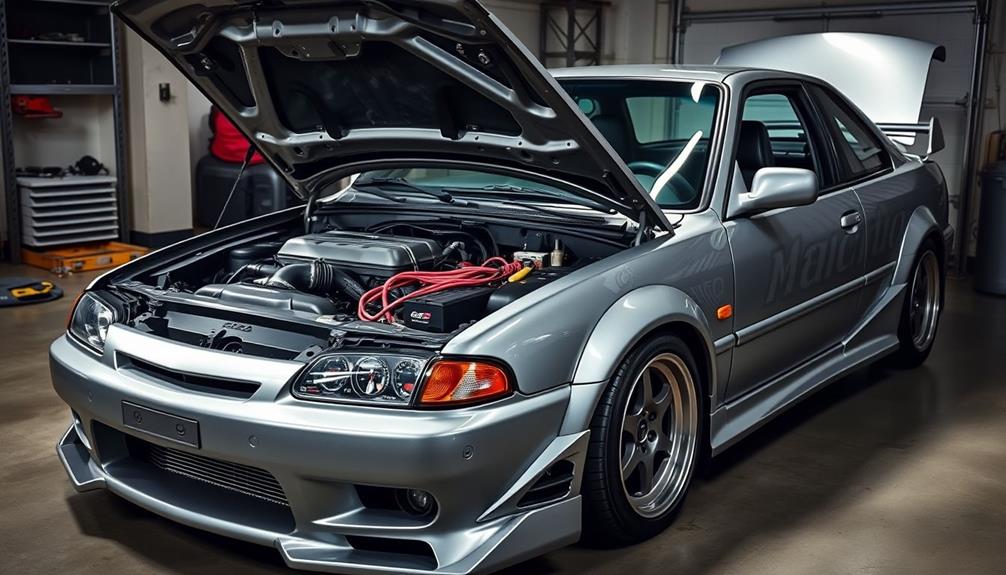
When diving into tuning your Mazda Protege, understanding ECU compatibility is vital for optimizing performance. The BG-series uses an air flow meter (AFM) for air volume measurement, while the BA-series employs an AFM for air mass. This difference greatly affects your tuning approach.
| Series | Knock Sensor | Recommended ECU Upgrade |
|---|---|---|
| BG-Series | Yes | Standalone ECU for enhanced tuning |
| BA-Series | No | Piggyback ECU for easier integration |
The BG-series features a knock sensor, which helps in detecting engine knock, making it more suited for forced induction applications compared to the BA-series that lacks this feature. When tuning, verify your ECU matches your engine specifications. This compatibility is vital, as the ECU controls functions like fuel injection and ignition timing.
Upgrading to a standalone ECU might require additional components, especially for the BA-series, like modifications to the ignition system to prevent overheating ignition coils. Community insights highlight the importance of proper tuning to maximize the benefits of modifications, whether you're considering piggyback solutions or a full standalone system. Remember, the right ECU gets you closer to achieving your performance goals.
Wiring Solutions and Modifications
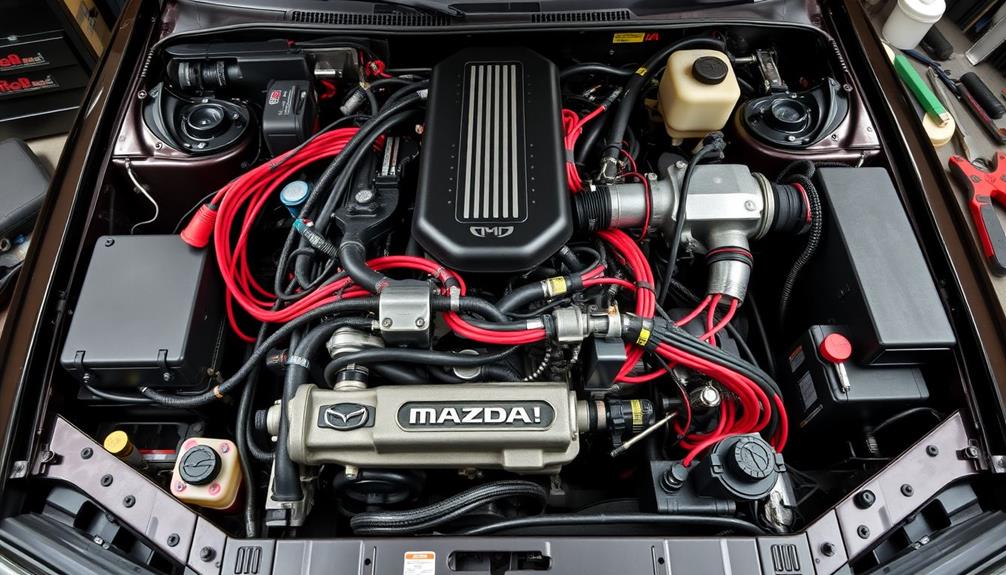
When tuning your Mazda Protege, custom wiring harnesses can make all the difference in ensuring compatibility with your performance upgrades.
You'll need to evaluate standalone ECU setups, especially since they might require extra components for proper ignition coil configurations.
Addressing these wiring solutions not only enhances engine management but also boosts your car's overall performance.
Custom Wiring Harness Benefits
Enhancing your Mazda Protege 1995 with a custom wiring harness can greatly improve both reliability and performance. By opting for a tailored solution, you're ensuring that essential connections—like those for the fuel pump, power, and ground—are streamlined. This not only enhances overall performance outcomes but also minimizes potential electrical issues.
Here are some benefits you can expect from a custom wiring harness:
- Simplified Installation: Get everything connected without hassle.
- Improved Compatibility: Perfectly integrates with aftermarket components.
- Enhanced Reliability: Reduces the risk of electrical failures.
- Real-Time Data Logging: Enables precise tuning adjustments on-the-fly.
- Tailored Solutions: Addresses unique challenges like the BA-series ignition system.
With a custom wiring harness, you can easily upgrade to more effective ignition systems, like COPS or MOSFET drivers, ensuring your Protege performs at its best.
Plus, the remote tuning capabilities allow for real-time feedback, enabling you to maximize performance outcomes. Investing in a custom wiring harness is a smart move for any enthusiast looking to elevate their Mazda Protege 1995.
Standalone ECU Considerations
Upgrading to a standalone ECU can considerably elevate your Mazda Protege 1995's performance, offering you the ability to fine-tune fuel injection and ignition timing with precision.
However, integrating a standalone ECU requires careful consideration of wiring solutions and modifications to maximize its tuning capabilities.
Custom wiring harnesses, like those from Carlos at BP Performance Specialty, are essential. These harnesses simplify connections for the fuel pump, power, and ground, making installation more straightforward.
The BA-series Protege presents unique challenges, particularly with the ignition coil integrated into the distributor. You might need to upgrade to a Coil-On-Plug (COPS) system or install a MOSFET ignition driver to achieve peak performance.
Compatibility is another critical factor. Confirm that your standalone ECU integrates seamlessly with your vehicle's electrical system, especially with BA-series models. Mismatched components can lead to performance issues and even overheating ignition coils.
Additionally, remote tuning options for standalone systems can simplify the process, allowing you to track performance metrics and make necessary adjustments.
With the right wiring solutions and modifications, you can release your Mazda Protege's full potential and enjoy the benefits of enhanced tuning capabilities.
Standalone ECU Considerations
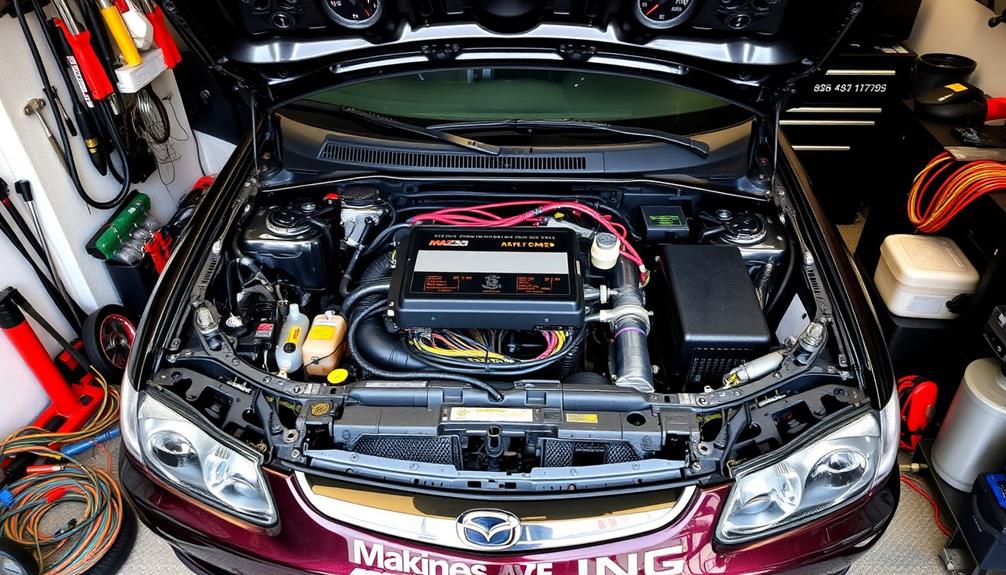
Integrating a standalone ECU into the BA-series Mazda Protege requires careful planning, especially due to its unique ignition coil setup. This setup lacks an IGBT-driver, meaning you'll need to upgrade to a coil-on-plug (COPS) system for peak performance.
When considering a standalone ECU, keep the following in mind:
- Enhanced tuning capabilities for fuel injection and ignition timing
- Potential challenges with overheating ignition coils
- The importance of proper electrical management
- The option of a Mitsubishi ECU for better driveability and reliability
- The necessity of a custom wiring harness for a seamless installation
A standalone ECU can greatly improve your vehicle's performance, but it's essential to address the ignition system's limitations.
You'll want to verify that all vital components, like the fuel pump and ground connections, are properly wired to maintain reliability.
Upgrade to a MOSFET ignition driver if you face coil issues; this can help prevent overheating.
With the right approach, you can release the full potential of your Protege while enjoying the benefits of a standalone ECU.
Common Performance Modifications
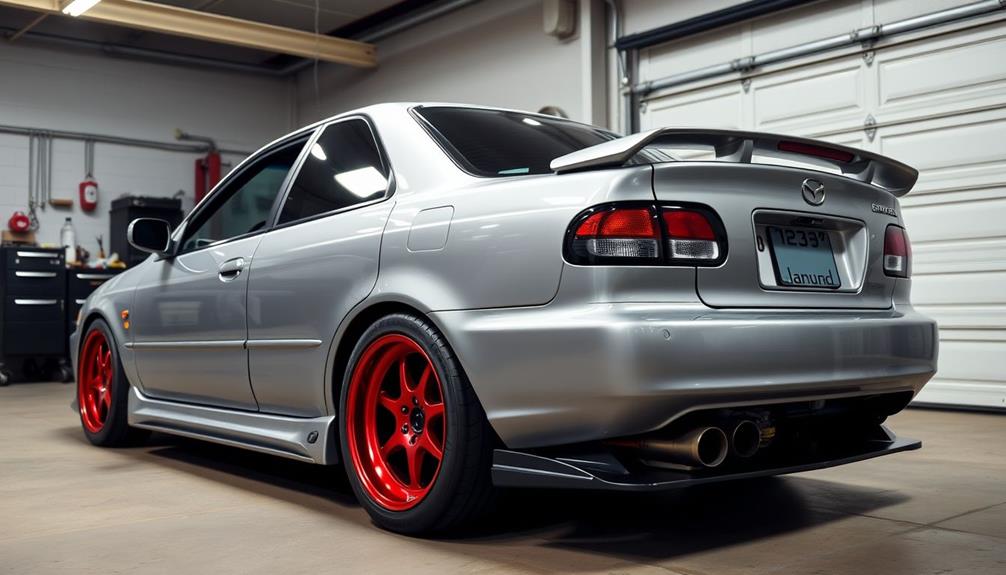
Performance modifications for the 1995 Mazda Protege can greatly transform your driving experience and boost engine capabilities. One of the most impactful upgrades you can make is installing a performance header. This component features equal-length runners that optimize exhaust flow, leading to noticeable increases in horsepower and torque, especially in the mid to upper RPM range.
Pairing your performance header with a cat-back exhaust system can further enhance your ride. This modification reduces back pressure, allowing your engine to breathe more efficiently and potentially adding an extra 5-10 horsepower. Plus, it gives your Protege a more aggressive sound that you'll love.
Don't overlook the benefits of upgrading your ignition components too. High-performance spark plugs and coil packs guarantee better combustion, resulting in improved throttle response and fuel efficiency.
Additionally, utilizing a performance-tuned ECU can considerably enhance your engine mapping for fuel and ignition timing, maximizing both power output and efficiency.
These common performance modifications not only enhance your car's capabilities but also make every drive more enjoyable. With the right upgrades, your Mazda Protege can truly become a standout in the compact car segment.
Community Insights and Experiences

How can the experiences of fellow enthusiasts enhance your tuning journey with the 1995 Mazda Protege? Tapping into community insights is essential for maximizing your car's performance and reliability.
You'll find that sharing knowledge not only helps you drive the car you love but also connects you with others who share your passion.
Here are some key takeaways from the community:
- Real-world build logs showcase both successes and challenges, helping you avoid pitfalls.
- Discussions about turbo upgrades and exhaust systems highlight their effects on horsepower and drivability.
- Online forums are valuable for troubleshooting common issues and seeking advice.
- Insights into ignition coil operation can guide you in effective tuning solutions.
- Fellow enthusiasts often recommend using tools like MS2 for better fuel injection management.
Frequently Asked Questions
How Much Horsepower Does a Mazda Protege Engine Have?
The Mazda Protege engine typically produces between 92 to 130 horsepower, depending on the model. If you've got the 1.6L engine, expect around 105 hp, while the 1.8L variant offers about 125 hp.
How Fast Is a Mazda Protege?
The Mazda Protege can reach a top speed of around 121 mph. With modifications, you might see speeds approaching 140 mph, making it a fun, agile car to drive while enjoying its performance capabilities.
How Much Horsepower Does a 99 Mazda Protege Have?
The 1999 Mazda Protege packs around 120 horsepower at the crank. You'll appreciate its blend of performance and efficiency, making it a solid choice for compact car enthusiasts who value both power and fuel economy.
Does Mazda Protege Have Turbo?
The Mazda Protege doesn't come with a factory-installed turbo, but you can enhance its performance with aftermarket turbo kits. Proper tuning and additional modifications will greatly increase power and efficiency for your driving experience.
Conclusion
In tuning your 1995 Mazda Protege, think of it like sculpting a block of marble; every modification chisels away to reveal the masterpiece within. Just as a sculptor carefully selects tools, you'll choose the right upgrades to maximize power and efficiency. Whether you're bolting on new components or diving into advanced engine upgrades, your journey will transform your compact car into a powerful ride that stands out on the road, just like a well-crafted statue in a bustling gallery.
